TLDR;
Size does matter, but quality matters more. When you’re writing a blog post especially for search engine optimization, remember that length is secondary to the quality of your post, the structure of the article, its readability, and its engagement level. In other words, focus on how long people actually spend on your post checking out images, video, or eye-catching lists and stats. That being said, it pays to heed the fact that people like reading long form content. If you can regularly hit 1,000-1,500 words, along with occasional 2,500 words posts, I believe your overall results will be better.
Since prevalent stats generally indicate that 2,500 is really an ideal word count for a post in regards to search engine traffic, we’ll add this: for keywords you’ve identified as definite opportunities and that face a lot of competition, the ideal remains 2,500.
Shall we put this more simply?
Regular content strategy: 1,000 word general blog posts
Heavy hitters, high competition, definite opportunities: 2,500 word blog posts
Recently, I put on a question on Twitter to check out if blog readers actually prefer reading long form content on the extreme end of the word count spectrum. Do the below results surprise you?
Clearly there is a preference for shorter content when the subject matter doesn’t actually require longer content. In fact, the most common answer I get from seasoned marketers on the above question is “Whatever it takes to make your point.” Simple – but is it easy?
When it comes visitors per word, the math is much less clear.
On one of our posts last year–– “What is the Best Blog Length for 2016” ––we had a very astute reader assert that four 250 word blog posts might do better than one 1,000 word post.
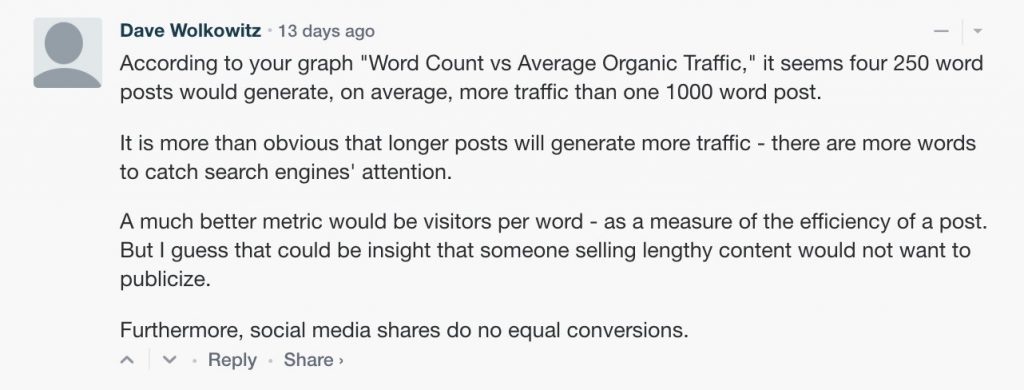
The misconception that this addresses is that it takes a lot of time to create an original, thoughtful 1000 word blog post that’s targeted at a high-traffic keyword phrase. Does the actual time it takes to write a long form post justify the amount of “high intent traffic,” or people that might be interested in your product or service? Maybe there are times when shorter posts would do the trick more efficiently.
So, rather than a hyperfocus on length, we really need to be thinking about how well our content is targeted, and who will be reading that content .
Yes, this might seem counterintuitive for a blog post about blog length, but the more you understand and internalize this truth, the more you’ll shed your concerns about having the so-called ideal amount of words in your blog posts. Once you’ve rid yourself of your anxieties about word count, you can start spending more time on creating highly targeted posts that serve a real purpose.
To be brutally honest, we know that three to five of our blog posts from the last year make up about 90% of the traffic we get to our site. So, shouldn’t the bulk of our efforts be in pursuit of creating other posts that really capture attention like this – instead of QUANTITY, QUANTITY, QUANTITY?
For those that haven’t had the benefit of reading why 2,500 words is the ideal length for major SEO opportunities with a lot of competition, check out the below graph.
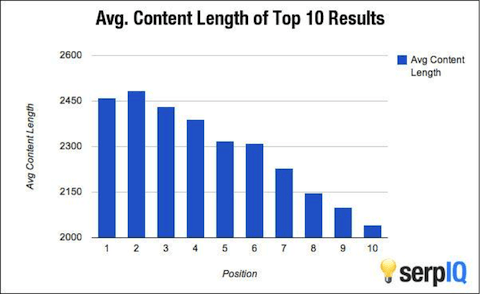
- Word count is one way to get Google’s attention: we have to understand that an inordinate amount of first page results for many competitive terms have a word count of 2,000+.
- If you really capture people’s attention with images, videos, infographics, bullet points and rich information – and keep them reading with 2,500 words of content that’s rich in information – you get a lower bounce rate with higher engagement. Time spent on page is a signal to Google that people didn’t just bounce back to the search results, and thus you’re rewarded: their algorithm updates to favor pages that indicate they were what the searcher was looking for.
- The stats have proven time and time again that this longer form content is ideal. Here are some graphs to help illustrate the point from the last couple of years:
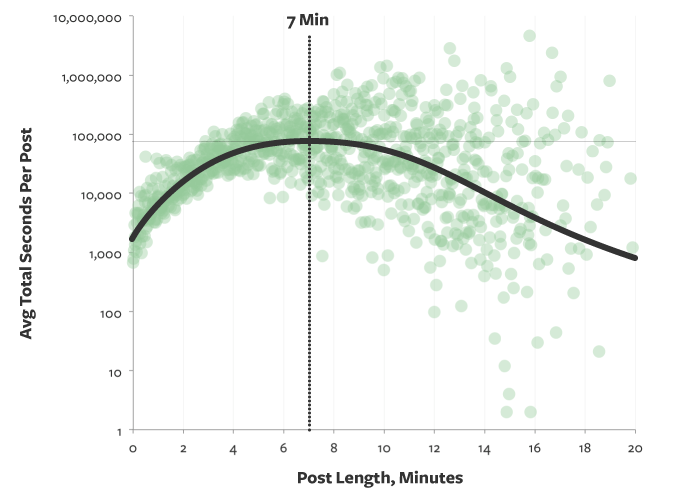
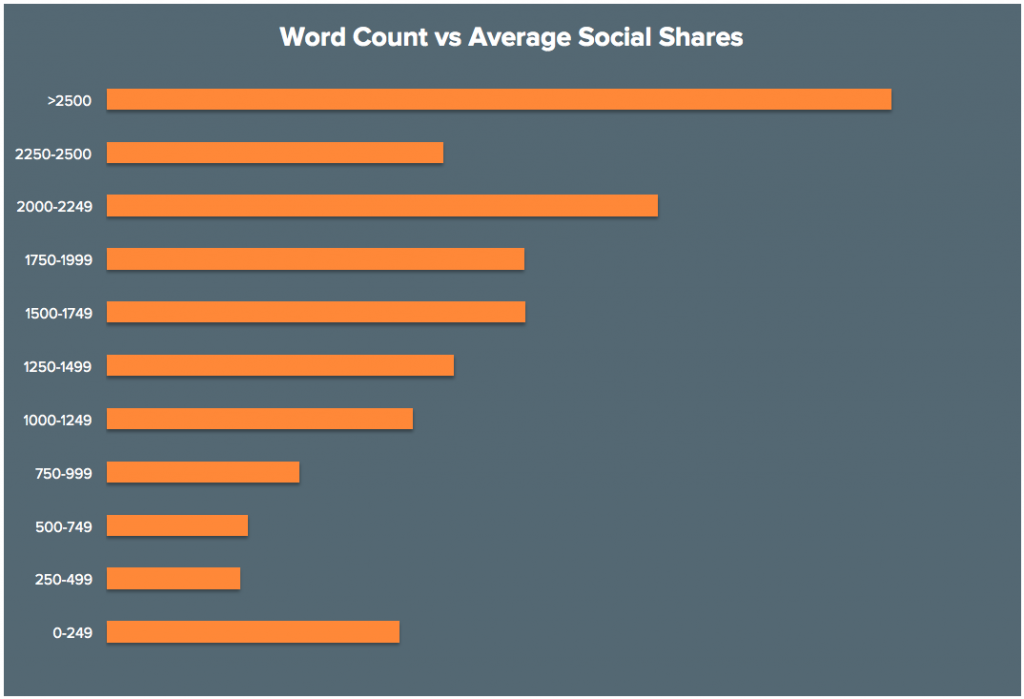
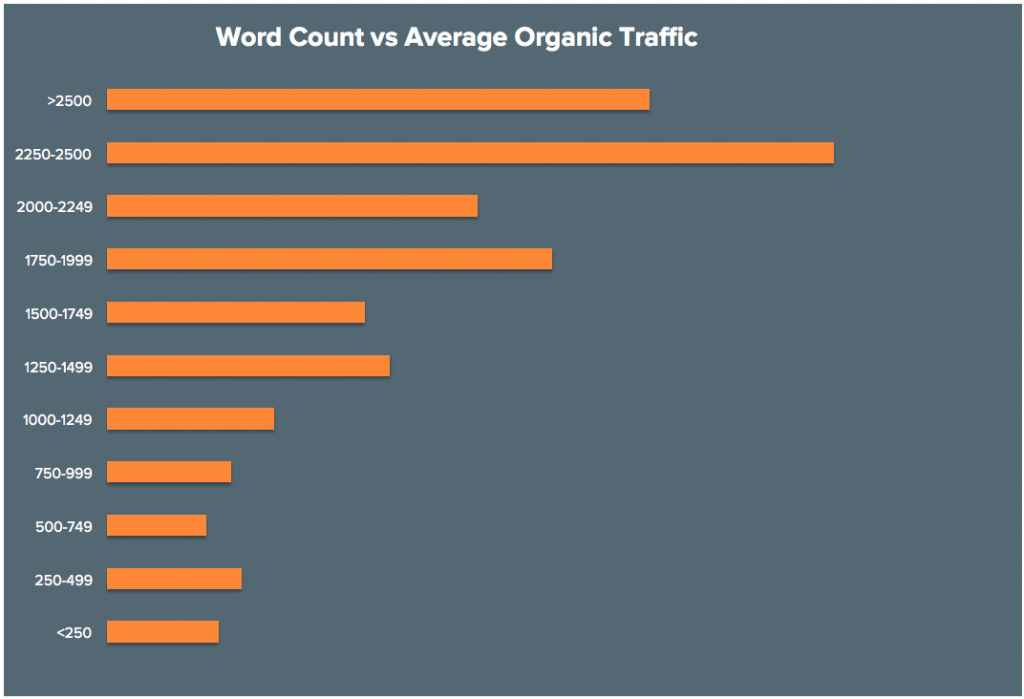
Are you wondering why would I suggest creating any blog posts that contain less than the ideal amount content?
Because as much as the purists would like to tell you, content strategy is not just about quality. There is also some evidence that suggests that the quantity of posts is important too. BuzzSumo recently published a very thorough study on why more content is upending the claim that quality is all that matters.

It’s interesting to note that The New York Times switched over to a quantity approach when Jeff Bezos took over — and that this shift is reflected by increasing numbers of unique visitors, as shown in the above graph. Of course, their approach has shifted in more ways than just volume – they are also using more video, allowing authors to A/B test headlines, and using data scientists to find patterns and learn from their best content. But it’s hard not to see volume as a major advantage when they can target more long tail searches that one might assume would bring negligible traffic. Yet over time, all of that long-tail content and traffic stacks up.
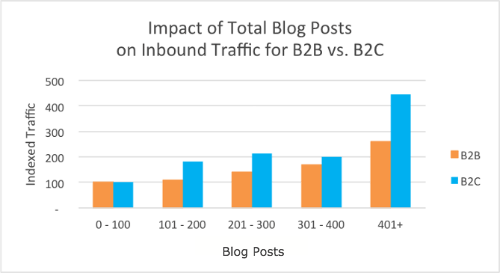
Ultimately, what is the ideal frequency for publishing blog posts?
The trick is to understand that even though someone may acquire more customers through blogging if they blog more than once a day, that the time required to post daily might not actually justify the increase in business. Ask yourself at what point it might be possible for you to get similar results for half of the work? Weekly blog posts might be a good place to start. If you truly don’t have a content strategy set up yet, then monthly posts might be the best place to start.
While weekly bloggers have a 66% chance of getting a customer through their blog, the fact remains that and blogging 2-3 times a week only brings that chance up 4%. That makes me wonder if most people might get the best return out of blogging either once a week or going full blog-rage and doing it multiple times a day. The latter strategy might make more sense with a full media/content team in house, which is more plausible for bigger brands but is less likely for your average small to mid-size business.
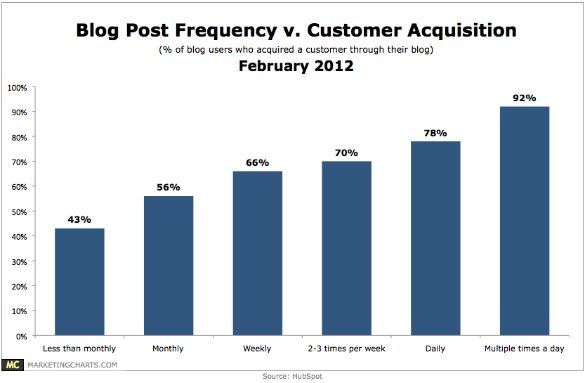
“If you’re using frequency as a tactic to make up for the fact that you’re being ignored, you can certainly do better.” – Seth Godin
Stop blogging now (for a time) if your content isn’t targeting visitors with SEO, and hasn’t been resonating with people on social channels.
It’s time to recalibrate.
When we’re kids, it’s not helpful to keep shooting basketballs or serving volleyballs poorly even after someone tells us we need to adjust our form. We ask how, and we learn. We diligently seek the right way to do it – the way that people have had the most success with in the past – so that we achieve good form before deliberate practice on a regular basis.
Really, I mean it: stop with the constant posting on your blog if you score only two visits the following week. Recognize that something else is wrong. You either need to adjust your ‘technical SEO’ or re-do your whole content strategy altogether. Too many people waste their time on content that either isn’t resonating with their core demographic, or simply isn’t targeted right from the beginning to opportunities for search traffic.
So how do we both target for search traffic, and resonate with our core demographic at the same time?
1. It starts with keyword research. There in an incredible number of viable tools out there for this, such as:
- Google Keyword Planner
- SEM Rush
- Spyfu
2. Secondly, we need creativity – and words that capture one’s attention to get a solid title that communicates a distinctly original piece of value to people that actually might be in need of our product or service:
- Have fun with alliteration: “Best Blog Length for Busy Bloggers”
- Use strong language: “Why People Hate Writing Long Blog Posts, and How to Make it Easier”
- Make the value clear: “3 Easy Steps to Writing Blog Posts with the Perfect Length“
- Add something visual in the title: “12 Graphs that Demonstrate Why Long Blog Posts are Better”
3. You put these two all important things together to form an attention-grabbing title, and then deliver on that promise of value with your writing and research. Then, utilize these 5 keys to a blog post to satiate someone’s desire for new information.
- Give them what they came for! Create trust and brand loyalty by over-delivering on the original promise that the title suggested. Otherwise you’ve just written click-bait – and you could actually be damaging your brand for the sake of some website traffic in the short term.
- Make it visual as soon as possible with a video, a graph, bullet points, an infographic, a funny meme or a gif.
- Don’t hide the payoff way down in the article unless you have mastered the hook in the first paragraph. Instead, try to give as much information as you possibly can right away, and then build on those points and flesh them out further in the body of the article. Don’t save anything for later: instead, share related information that someone looking for the original topic would enjoy and benefit from. For instance, this article starts off with the value of “The best length for a blog article in 2017” and moves on to the best frequency for blog posts, and then how to deliver on value with your blogging strategy as well.
- Think about your core demographic the entire time you are writing your blog post–especially the subset of your core demographic that’s looking for this information. How can you wow them with your information? Potentially, your goal might be to simply inform customers that you’re an expert or a company providing a service, and that you have far more important information than you could ever provide in even a 1,000 to 2,500 word blog post. This way you, are giving as much value as possible but also hinting at the limitation of knowledge transfer in an industry where your product or service is a popular solution. I always steer people away from outright selling in a blog post – but there’s nothing wrong with being real about the limitations of getting all necessary info from a post.
- Remember to recap. Just as you wanted to try to stuff as many takeaways at the beginning of the article for people skimming, you will want to re-cap at the end of the post as well like this…
To Recap…
The best blog length is going to be the one that you can actually implement with consistency. From my experience with internal and agency teams of small to mid-size businesses – excluding enterprise level companies – I would suggest the following strategy:
- One monthly 2,500 monthly blog post that serves a more competitive but high value keyword opportunity.
- One weekly 1,000 word blog post that allows you to stay in front of your audience, essentially ping Google that your site is serving up fresh content and serve the long-tail, less competitive keywords.
- Spend more time on the actual keyword targeting, creativity with blog concept and the time spent promoting really great pieces of content instead of pushing out a bunch of ‘commodity content’ blog posts on a regular basis.
